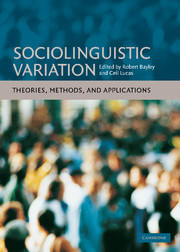Book contents
- Frontmatter
- Contents
- 1 List of figures
- 2 List of tables
- Acknowledgments
- Notes on editors and contributors
- Introduction
- Part 1 THEORIES
- 1 Variation and phonological theory
- 2 Syntactic variation
- 3 The psycholinguistic unity of inherent variability: old Occam whips out his razor
- 4 The study of variation in historical perspective
- 5 Style in dialogue: Bakhtin and sociolinguistic theory
- 6 Variation and historical linguistics
- 7 Second language acquisition: a variationist perspective
- 8 Variation and modality
- Part 2 METHODS
- Part 3 APPLICATIONS
- Afterword: Walt Wolfram and the study of sociolinguistic variation
- References
- Index
5 - Style in dialogue: Bakhtin and sociolinguistic theory
Published online by Cambridge University Press: 16 February 2010
- Frontmatter
- Contents
- 1 List of figures
- 2 List of tables
- Acknowledgments
- Notes on editors and contributors
- Introduction
- Part 1 THEORIES
- 1 Variation and phonological theory
- 2 Syntactic variation
- 3 The psycholinguistic unity of inherent variability: old Occam whips out his razor
- 4 The study of variation in historical perspective
- 5 Style in dialogue: Bakhtin and sociolinguistic theory
- 6 Variation and historical linguistics
- 7 Second language acquisition: a variationist perspective
- 8 Variation and modality
- Part 2 METHODS
- Part 3 APPLICATIONS
- Afterword: Walt Wolfram and the study of sociolinguistic variation
- References
- Index
Summary
Introduction: style in sociolinguistics
Issues of “style” have been addressed in variationist sociolinguistics since the earliest work of William Labov. In his pioneering New York City study (1966) Labov operated with two dimensions of linguistic variation: the “social,” that is, the range of variation for particular sociolinguistic variables across the different speakers that he recorded; and the “stylistic” dimension, the range of variation produced by individual speakers within their own speech. This approach was adopted in the urban US studies which followed close upon Labov, notably in Detroit (Wolfram 1969).
In this tradition, style was tightly defined on both the linguistic and social dimensions. The language features examined in Labov's initial work were micro aspects of linguistic structure – two or more specific sounds which can alternate as variants of one linguistic “variable.” Typical is the choice between whether to pronounce an /r/ after a vowel or not in words such as car or card. As studied by Labov in New York City (1966) and Wolfram and associates in Detroit (Shuy, Wolfram, and Riley 1968a), the choice is treated as different ways of saying the same thing. Pronouncing the /r/ is prestigious in these communities and throughout most of North America, omitting it is not prestigious (although the opposite is true in some other speech communities, for example in England). Counting the relative frequencies of such alternative pronunciations has shown how they vary depending on who the speaker is, the linguistic context, and the social context, including the situation he or she is in.
- Type
- Chapter
- Information
- Sociolinguistic VariationTheories, Methods, and Applications, pp. 90 - 109Publisher: Cambridge University PressPrint publication year: 2007
- 20
- Cited by



